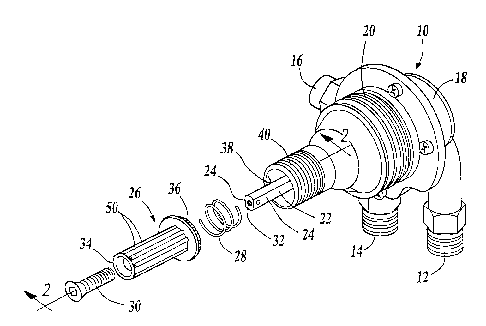Some of the information on this Web page has been provided by external sources. The Government of Canada is not responsible for the accuracy, reliability or currency of the information supplied by external sources. Users wishing to rely upon this information should consult directly with the source of the information. Content provided by external sources is not subject to official languages, privacy and accessibility requirements.
Any discrepancies in the text and image of the Claims and Abstract are due to differing posting times. Text of the Claims and Abstract are posted:
| (12) Patent: | (11) CA 2305044 |
|---|---|
| (54) English Title: | TEMPERATURE LOCK STOP FOR FAUCETS |
| (54) French Title: | BUTEE DE VERROUILLAGE DE TEMPERATURE POUR ROBINETS |
| Status: | Term Expired - Post Grant Beyond Limit |
| (51) International Patent Classification (IPC): |
|
|---|---|
| (72) Inventors : |
|
| (73) Owners : |
|
| (71) Applicants : |
|
| (74) Agent: | PIASETZKI NENNIGER KVAS LLP |
| (74) Associate agent: | |
| (45) Issued: | 2003-03-18 |
| (22) Filed Date: | 2000-04-13 |
| (41) Open to Public Inspection: | 2000-12-29 |
| Examination requested: | 2000-06-07 |
| Availability of licence: | N/A |
| Dedicated to the Public: | N/A |
| (25) Language of filing: | English |
| Patent Cooperation Treaty (PCT): | No |
|---|
| (30) Application Priority Data: | ||||||
|---|---|---|---|---|---|---|
|
A water mixing valve (10) can selectively adjust temperature by selection mixing of the hot and cold water supplies and be selectively locked in place by a knob (26) fastened via a threaded faster (30). The knob (26) has a spline section (34) seated in a complementary spline section (36) in the valve body (20) to prevent the knob (26) and operating stem (22) from inadvertent rotation.
Une vanne de mélange d'eau (10) peut de manière sélective ajuster la température par mélange sélective des alimentations en eau chaude et en eau froide et peut être verrouillée en position de manière sélective par une poignée (26) fixée via une fixation filetée (30). La poignée (26) présente une section cannelée (34) logée dans une section cannelée complémentaire (36) dans le corps de vanne (20) pour empêcher la poignée (26) et la tige de manuvre (22) d'être manuvrées par inadvertance.
Note: Claims are shown in the official language in which they were submitted.
Note: Descriptions are shown in the official language in which they were submitted.

2024-08-01:As part of the Next Generation Patents (NGP) transition, the Canadian Patents Database (CPD) now contains a more detailed Event History, which replicates the Event Log of our new back-office solution.
Please note that "Inactive:" events refers to events no longer in use in our new back-office solution.
For a clearer understanding of the status of the application/patent presented on this page, the site Disclaimer , as well as the definitions for Patent , Event History , Maintenance Fee and Payment History should be consulted.
| Description | Date |
|---|---|
| Inactive: COVID 19 - Reset Expiry Date of Patent to Original Date | 2020-06-16 |
| Inactive: COVID 19 - Deadline extended | 2020-06-10 |
| Inactive: COVID 19 - Deadline extended | 2020-05-28 |
| Inactive: COVID 19 - Deadline extended | 2020-05-14 |
| Inactive: COVID 19 - Deadline extended | 2020-04-28 |
| Inactive: Expired (new Act pat) | 2020-04-13 |
| Inactive: COVID 19 - Deadline extended | 2020-03-29 |
| Common Representative Appointed | 2019-10-30 |
| Common Representative Appointed | 2019-10-30 |
| Letter Sent | 2015-09-02 |
| Letter Sent | 2015-09-02 |
| Letter Sent | 2015-09-02 |
| Appointment of Agent Requirements Determined Compliant | 2014-03-27 |
| Revocation of Agent Requirements Determined Compliant | 2014-03-27 |
| Inactive: Office letter | 2014-03-26 |
| Inactive: Office letter | 2014-03-25 |
| Inactive: IPC from MCD | 2006-03-12 |
| Grant by Issuance | 2003-03-18 |
| Inactive: Cover page published | 2003-03-17 |
| Inactive: Final fee received | 2003-01-07 |
| Pre-grant | 2003-01-07 |
| Amendment After Allowance Requirements Determined Compliant | 2002-12-23 |
| Letter Sent | 2002-12-23 |
| Amendment After Allowance (AAA) Received | 2002-11-20 |
| Letter Sent | 2002-08-07 |
| Notice of Allowance is Issued | 2002-08-07 |
| Notice of Allowance is Issued | 2002-08-07 |
| Inactive: Approved for allowance (AFA) | 2002-07-23 |
| Application Published (Open to Public Inspection) | 2000-12-29 |
| Inactive: Cover page published | 2000-12-28 |
| Amendment Received - Voluntary Amendment | 2000-07-24 |
| Letter Sent | 2000-06-30 |
| All Requirements for Examination Determined Compliant | 2000-06-07 |
| Request for Examination Requirements Determined Compliant | 2000-06-07 |
| Request for Examination Received | 2000-06-07 |
| Inactive: First IPC assigned | 2000-06-02 |
| Inactive: IPC assigned | 2000-06-01 |
| Filing Requirements Determined Compliant | 2000-05-18 |
| Inactive: Filing certificate - No RFE (English) | 2000-05-18 |
| Application Received - Regular National | 2000-05-17 |
| Letter Sent | 2000-05-17 |
There is no abandonment history.
The last payment was received on 2002-03-18
Note : If the full payment has not been received on or before the date indicated, a further fee may be required which may be one of the following
Patent fees are adjusted on the 1st of January every year. The amounts above are the current amounts if received by December 31 of the current year.
Please refer to the CIPO
Patent Fees
web page to see all current fee amounts.
Note: Records showing the ownership history in alphabetical order.
| Current Owners on Record |
|---|
| DELTA FAUCET COMPANY |
| Past Owners on Record |
|---|
| ALFRED C. NELSON |